14:44.6N 017:29.9W
Our flight planning
calculations showed an estimated
flight of 11
hours and
45 minutes.
Different considerations were
taken into account to determine the best time for
departure: The first priority was to arrive
after sunrise at the
Inter
Tropical Zone where storm activities
are
typically at the lowest level,
and to
positively see the weather. The
second
important thing was the time difference
between Brazil and Senegal, which we
had to consider. Thirdly, with any possible
delays, we wanted to absolutely
arrive at our destination during
the day, just in case! Having taken all this into account,
our take-off time
was then scheduled for a quarter to midnight.
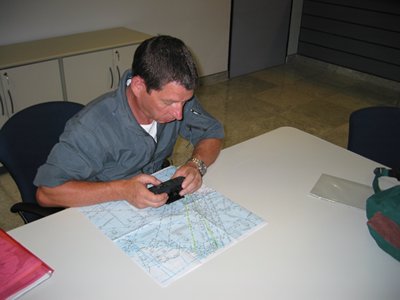
Olivier double checking our routing, and all the compulsary
reporting
points on our route across the big pond just before departure..
The day of our
departure was very relaxing, with very
little food and
drinks, and
even a few
hours sleep that afternoon.
We made our way to the airport at 9:00 p.m. to
have sufficient time to complete
the usual administrative tasks: Met office,
Flight planning, customs, the last check of our
programmed reporting points on our two
handheld GPS's,
etc.At
11:20 p.m.,
the heavily loaded I-IB-PON requested and
obtained
start-up and our IFR clearance.
We were assigned runway 18 for takeoff
into the clear, but dark night. Cleared for
takeoff, we
accelerated swiftly and were
airborne one-quarter
of the way down the runway.
Nicely
climbing at about 800 feet-per-minute, we headed due south
over the illuminated southern part of Recife
and crossing the shoreline.
At 3,000 feet,
the tower requested us to turn on course to intersection PACO and to contact Centre. For the next
two hours,
and climbing to our initial flight level 070, we were in
VHF contact
with Recife and reported regularly
on our progress.
A short while later, we were requested,
to use HF communication. Abeam
of the
island of Fernando de Noronha,
we
climbed
to our planned final cruising
flight level 120. The night was clear
with a few clouds below and a full moon
to the right. Nicely
progressing as per
plan and having that full illuminated Christmas
tree-like instrument panel in front
of us, we both scanned all
parameters
and carefully followed the fuel management
procedure.
To make things less
monotonous, we connected a CD player to our intercom and were
enjoying
some nice relaxing music on the way.
Communication
on HF with Recife Atlantico
faded out
after about three-and-a-half hours, and it was at this moment when
someone called us loud and
clear on
8861 KHz: "Hotel Bravo Papa
Oscar November, this is Dakar Oceanic Control,
do you read"? From there,
we had perfect communication with
them, and
reported in regular intervals
our
position and estimates.
As time passed, and
the moon rose over the top of
the cabin, we observed how
the horizon to the east started to lighten up
in a light rose-coloured fashion.
The sunrise was just absolutely spectacular
in colours, with larger clouds visible
in the distance.
Below us the sea was
clearly visible and it appeared that
the water was rather calm.
Hoopla!
To the right, way below, we could make out a cargo
boat heading in
a southerly direction. This
happened to
be the only
vessel we observed during the
whole crossing!
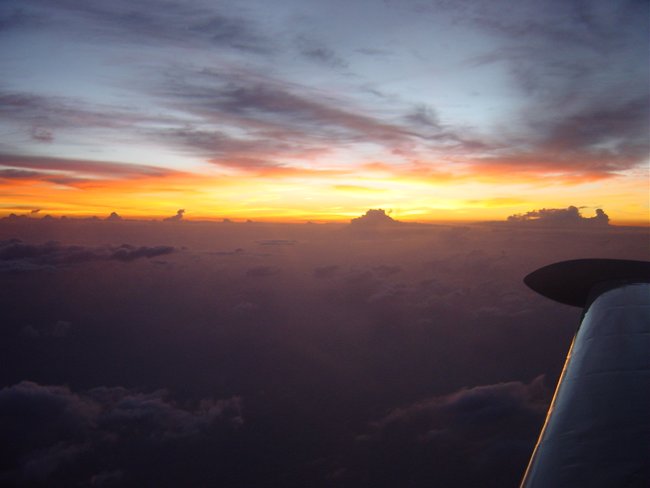
Early
morning and first light on the horizon
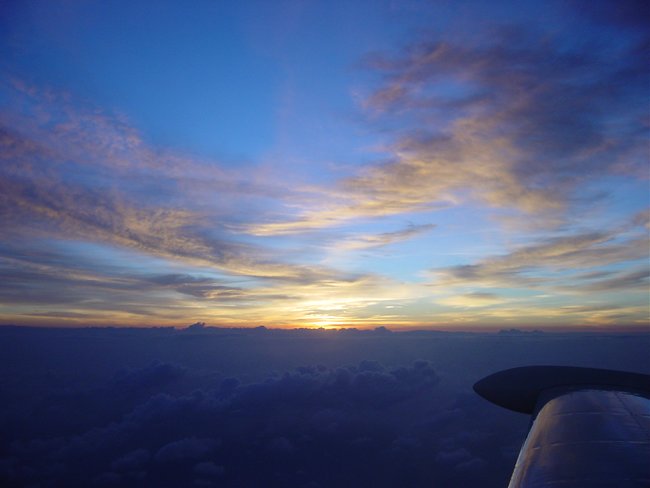
Large towering
clouds appeared in front of us, as we
clearly approached
the Inter
Tropical
Conversion Zone on top
of a solid cloud layer, and we
could observe
the first
echoes of the electromagnetic activities on
our storm
scope.

About another two hours on, in order not to penetrate the solid
cloud layer, we later had to climb to FL 140 and use our
oxygen. From that point on,
we had to change our
heading constantly,
to
fly between and around those gigantic CB towers.
We managed this phase pretty well, by constantly looking
outside and by observing our storm
scope carefully, which I would
not have missed for anything
at
this moment. Obviously we were
loosing time through this
slaloming around bad
weather, and our estimates for Dakar got pushed out again and
again for the
next three
hours.
From satellite images, which we printed out before our
departure, we expected
to pass the
most active
zone of the ITCZ when
approaching the reporting point
LIROL.
This proved to
be the case as we progressed and
descended again to our cruising
level FL120.1 indicated our
last estimate
for our
arrival of 13:20
hours to Dakar and
the actual
weather was reported with a visibility of 3 kilometres in haze,
temperature 23 a
QMH
1023.
One minute barely passed, when all of a sudden there was a
light burning
smell, a
light mechanical
sounding bang, and
Olivier and I looked at each other
equally
surprised!
Scanning the panel I noticed that the
load meter
indicated no load and the voltmeter
read 12.0 volts. At this moment I realized that we had lost our
alternator four
hours out from our destination, over the ocean, and soon would be
faced with a total power
failure.
What next?
Immediately I called up Dakar Oceanic
Control on
HP 8861 and
informed them, "Hotel
Oscar November, we have just experienced serious
electrical problems
and will be
faced with a
total electrical power failure shortly.
Expect us to
arrive at
Dakar as last
indicated at 13:20 hours. Do not expect any more position
reporting
from us from now
on.
We will try to
contact you with a battery operated
VHF
transceiver, when in
range." Dakar control
responded:
"Copied your message!
Good luck."
A lot of things went through my mind at this moment, but no
panic
developed at
all. Radios master switch off
first, then the master switch!
>From now
on, and
for the remaining four hours, the engine performed with the constant familiar noise that was perfect, but
on the instrument panel
things looked
quite unusual,
with the major part of the instruments inoperable, including all the
fuel
gages. It was good I kept an accurate
log
in writing of the fuel management of my
seven tanks!
My co-pilot Olivier became very active
and very
handy to me to keep us on course,
with his portable Garmin GPS, and
the nice graphic display, he carefully
pre-programmed in Recife before our
departure. My own portable GPS was
also in use during that time and the
two units completely agreed with
their readings, of course.
After three-and-a-half hours, we could
almost make
out the coastline of the Dakar
area in haze and we repeatedly called approach and Dakar tower,
with our ICOM handheld,
but got no answer.
At this moment, we started
our descent down to 4,000
feet and continued direct to
our destination.
It was clear to me that I should get
in radio
contact with the tower and prepare
for a visual approach in reduced visibility and manage the manual
gear extension
and a smooth landing.
It was the same procedure as every year when I assisted my
A&P on
each annual
inspection of
my Comanche, and insisted to practice at the end
of
the process,
one or two
manual extensions of the
gear, while the aircraft was on jacks, with
subsequent reengagement, which made me react cool
to
this situation. About five miles out
from the field,
the tower finally confirmed hearing us and
gave us clearance to land straight in on
runway 03.
As I had been in Dakar (GOOY)
some years ago, I knew the place and
asked for runway 36, which was
a much
longer runway, to guarantee better
conditions for what we were up
against.
The GPS
showed us being very
close to the airport, I finally located the tower area and made left turn
overhead and told
tower,
that we were landing
on runway
36.
Master and gear circuit breaker - IN, Master switch - ON,
Instrument lights
- OFF,
Covering plate -
OFF, speed below 100
MPH,
place selector in
"gear down locked"
position, and
disengage motor -raise motor, release
arm and push
handle forward through full travel.
Bingo! A "green light" - hurray!
The landing, after 13 hours and eight
minutes in the air, was long and smooth on
purpose, while Olivier pushed the gear
extension handle hard
forward with
his foot. We rolled out and taxied to
the assigned parking on the apron between
a Lufthansa 747 cargo plane and an
old DG8.
After shutting down our engine, we remained seated in the
cockpit for a moment,
looked at each other and were so happy to be
finally
safe and on
firm ground again.
Immediately we walked to the radio office, and later to the
tower, where
we received
a friendly
welcome. In fact, we learned
that air traffic control
mastered the
situation
brilliantly, in closing the Dakar
airspace 15 minutes before our expected arrival, to allow us a safe
arrival and landing.
Thank you guys!
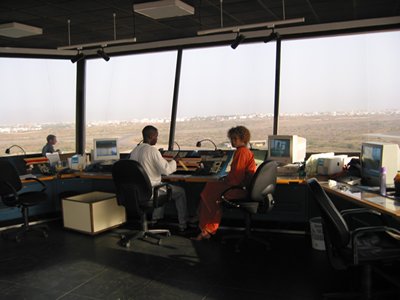
Up
at the Dakar Control Tower
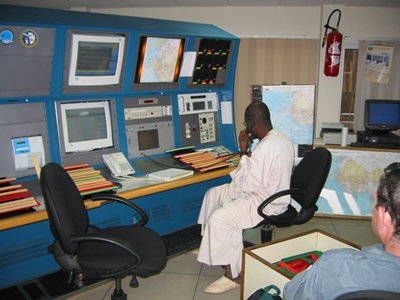
The Air Trafic Controller we talked to over
HF
across the South Atlantic
The same afternoon, we first had a couple of beers, and then we were busy
assessing the damage.
With the help of a very
competent
local
mechanic, we found out that the rear
bearing of our brand new
alternator had
gone, and the cooling fan
of
the
alternator had
separated
in two
parts.
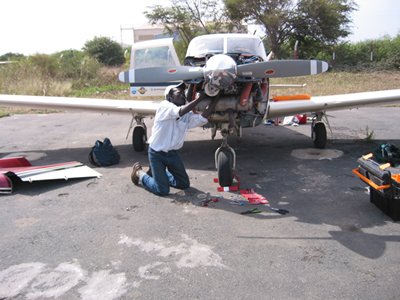
Kindness and real professionalism by the local aircraft Mechanic, to get HB-PON into the air again







